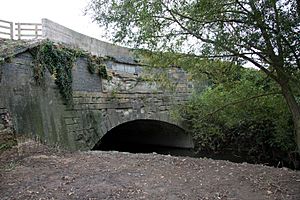Semington Aqueduct facts for kids
Quick facts for kids Semington Aqueduct |
|
|---|---|
 |
|
| Coordinates | 51°20′51″N 2°08′57″W / 51.3476°N 2.1493°W |
| OS grid reference | |
| Carries | Kennet and Avon Canal |
| Crosses | Semington Brook |
| Locale | Semington |
| Maintained by | British Waterways |
| Heritage status | Grade II |
| Characteristics | |
| Total length | 46 feet (14.0 m) |
| Width | 40 feet (12.2 m) |
| Traversable? | Yes |
| Towpaths | NW Side |
| Number of spans | One |
| History | |
| Construction begin | 1794 |
| Construction end | 1807 |
The Semington Aqueduct is a special kind of bridge that carries a canal over a river or valley. This one is located in Semington, Wiltshire, England, in the United Kingdom. It helps the Kennet and Avon Canal cross over the Semington Brook, allowing boats to travel smoothly.
Contents
Building the Kennet and Avon Canal
Why was the canal built?
Imagine being able to travel by boat all the way from Bristol to London! That was the big idea behind the Kennet and Avon Canal. People first thought about connecting the River Avon to the River Thames back in the late 1500s, during the time of Queen Elizabeth I. This connection would make it much easier to move goods and people across England.
Planning the route
A clever engineer named John Rennie mapped out the best path for the canal. The original plan was to go through Marlborough and Calne. However, they decided to change the route. The new path would take the canal through Devizes and Semington instead.
When did work begin?
In 1794, a special law called an Act of Parliament was passed. This law gave permission to start building the canal. Work began soon after.
Opening the canal sections
The eastern part of the canal opened first. The section from Newbury to Hungerford was ready in 1798. The next year, the part from Hungerford to Great Bedwyn opened.
The western section, which includes Semington, was mostly finished by 1804. But there were two big gaps that needed to be completed. These were the locks at Bath and the famous Devizes locks.
Completing the locks
The locks at Bath connected the canal to the River Avon. The Devizes locks were a huge challenge. They needed to lift or lower boats by about 72 meters (237 feet)! Both sets of locks were finished in 1810. Finally, on December 28, 1810, the entire Kennet and Avon Canal was open for boats to use.
How the Semington Aqueduct was built
Choosing the location
John Rennie's canal route went north of a village called Seend. West of Seend, the Semington Brook flows north and then turns west towards the River Avon. The canal needed to curve south to meet this valley. Then, it followed the north bank to reach Semington. To continue towards Trowbridge, the canal needed to cross the valley. This meant building an aqueduct over the brook.
Who built the aqueduct?
The job of building the Semington Aqueduct went to two builders: James McIlquham and James Porteous. These two had worked together before on another big project, the Leeds and Liverpool Canal. Porteous had even tried to get the job for the Lune Aqueduct on the Lancaster Canal, but he didn't get that one.
Luckily, they won the contract for the Semington Aqueduct. This contract also included building the Avoncliff Aqueduct near Bradford-on-Avon. They did a great job on both. Because of their success, they later won the contract to build the Dundas Aqueduct at Limpley Stoke.
Design of the Aqueduct
The Semington Aqueduct is made mostly of strong limestone blocks. It has one main arch that helps it cross the brook. If you look closely, you might see some repairs made with special engineering bricks.
On both sides of the aqueduct, there's a rectangular panel with a design. It looks like it might have once had writing on it, but there's no sign of any words now. This aqueduct is considered an important historical structure. It has been a Grade II listed building since 1988. This means it's protected because of its special history and design.

